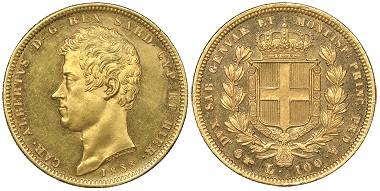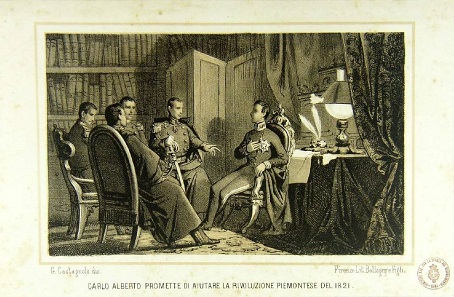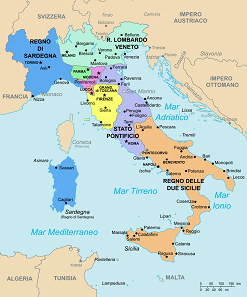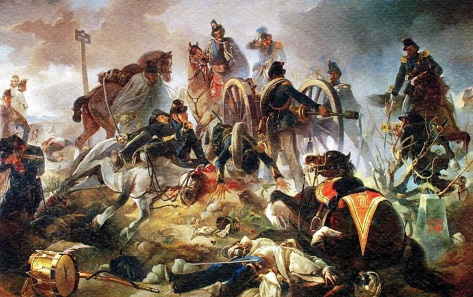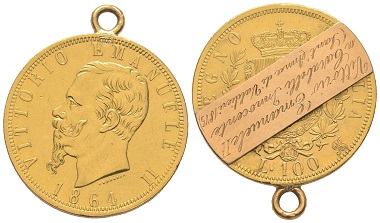On November 17, 2018, the Monaco-based Auction house Éditions Victor GADOURY will auction off an extensive collection of coins and medals of the Casa Savoia originating from the possessions of a gentleman of the royal family. Part 1 and 2 will tell you more about their beginnings and the ascension the throne.
Carlo Alberto, 1831-1849. 100 Lire, Turin, 1833. MIR 1043c. Unique in this condition. NGC Proof63 Cameo. Estimate: 20,000 euros. From Gadoury Auction (November 17, 2018), no. 1735.
Chapter 6: The Road to Royalty
The Carbonari’s revolt and the failed Risorgimento
Vittorio Emanuele I did not show any understanding regarding the fact that the French revolution had changed people’s awareness. While the first Carbonari had been up in arms against the foreign rule of the French, they were now fighting the absolutistic reaction.
Carlo Alberto promises the insurgents of 1821 his support. Fictional copperplate print made between 1850 and 1875.
After the successful riot in the Kingdom of Sicily, a delegation of the Carbonari marched to Turin and enforced a liberal constitution as well as the constitutional monarchy. Vittorio Emanuele, who was not willing to accept this, resigned in favor of his brother Carlo Felice. As the latter was residing in Modena, however, Carlo Alberto – a descendant of the Savoy-Carigano branch line, which Prince Eugene had also been a member of – was entrusted with the rule for a brief period of time. Due to his liberal convictions, he was considered a sympathizer of the Carbonari. Thus, Carlo Alberto took an oath on the new constitution holding the tricolor in his hand.
When Carlo Felice arrived in Turin, he was accompanied by Austrian troops which he used to end the episode of the Carbonari. Carlo Alberto had to go into exile. The kingdom once again turned reactionary and the Carbonari once again restored their underground activity.
But Carlo Felice died childless in 1831. The liberal Carlo Alberto succeeded him and became the shining light of all Italian liberals. In 1837, he introduced a liberal civil code. He had railways built and strengthened the industry. In 1848, he issued the Statuto Albertino which turned his kingdom into a constitutional monarchy.
Italy at the time of Carlo Alberto. Map: Gigillo83. CC-BY 3.0.
While the French and Austrian rebels of 1848 were mainly demanding more political participation, Italy was primarily concerned with the country’s political unity and the liberation from rulers who were considered “foreign”. The King of Sardinia served as a fitting figurehead because he was the only secular ruler in Italy who was actually considered Italian. Which is why the Risorgimento’s protagonists repeatedly asked Carlo Alberto to become the leader of the independence movement. And the Savoy actually did declare war on the Danube Monarchy.
Luigi Norfini (1825-1909), Scenes of the Battle of Novara.
The Battle of Novara ended the dreams of an Italian independence for the time being. Carlo Alberto resigned on the very same day in favor of his son Vittorio Emanuele II and went into exile in Portugal where he then died a few months later.
Savoy forced to pay reparations amounting to 75 million French francs, which left only little freedom of action to Vittorio Emanuele II. But at least he did not have to accept territorial losses.
Vittorio Emanuele II. 100 lire, Turin, 1864. MIR 1076a (R3). Incl. a loop and a hand-written note stating that this was a gift from Vittorio Emanuele given to Carabelli Innocente in 1875. Very fine+. Estimate: 1,000 euros. From Gadoury Auction (November 17, 2018), no. 1745.
The King of Sardinia becomes the King of the Italians
Vittorio Emanuele continued his father’s liberal course of action. The division of church and state was finalized, the army was reorganized, administration and jurisdiction were modernized. Due to a number of economic liberalizations, Vittorio Emanuel’s kingdom became one of the most advanced in all of Europe and it did not struggle to pay reparations.
And Vittorio Emanuele became the symbolic figure of the Risorgimento. Viva Verdi meant nothing other than Viva Vittorio Emanuele Re d’Italia. However, Italy’s independence could not be achieved single-handedly. Which is why Savoy joined France. And the latter considered the weakening of the Habsburg monarchy a decisive advantage for its own empire.
Deliberate provocations caused the Austrian army to invade Piedmont in 1859. This constituted a case of alliance and France supported Vittorio Emanuele in the Austro-Sardinian War. The Battle of Solferino ended the Austrian reign in Northern Italy. Vittorio Emanuele received Lombardy as part of the Peace of Villafranca. Napoleon III also profited from this situation: The Duchy of Savoy, home territory of the Casa Savoia, became part of France.
We do not have to recount the entire history of the Risorgimento at this point. We all know how it ended. Vittorio Emanuele II was proclaimed king on March 17, 1861.
Vittorio Emanuele III. Trial piece of 100 lire, Rome, 1910 R. Extremely rare. NGC Proof66. Estimate: 150,000 euros. From Gadoury Auction (November 17, 2018), no. 1759. Diameter 38 mm.
His descendants, Umberto I and Vittorio Emanuele III, led Italy through the vicissitudes of the history of the 19th and 20th century more or less successfully.
Let us end with the notion that Vittorio Emanuele III would have enjoyed this coin collection that will be auctioned off at Gadoury on November 17, 2018. After all, he did go down in numismatic history as a great coin collector and the initiator of the Corpus Nummorum Italicorum.
Read Part 1 and 2 of the series here and here.
In CoinsWeekly you can also read a comprehensive Auction Preview.




